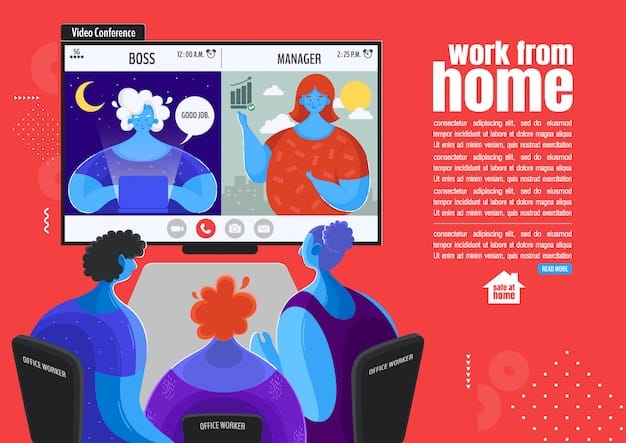Optimizing US Remote Team Technology: Platforms for Enhanced Collaboration

US Remote Team Technology focuses on selecting the best communication and collaboration platforms to enhance productivity and connectivity within remote teams across the United States.
In today’s digital age, **US Remote Team Technology: Selecting the Best Platforms for Communication and Collaboration** is crucial for companies looking to maintain productivity and cohesion among their distributed workforce. Choosing the right tools can significantly impact team morale, efficiency, and overall success. Let’s dive into how to make informed decisions about technology for your remote team.
Understanding the Landscape of US Remote Team Technology
Remote work has become increasingly prevalent in the US, necessitating a robust understanding of the technologies that facilitate seamless communication and collaboration. This involves recognizing the unique challenges faced by remote teams and identifying the specific tools that address these needs.
Key Challenges in Remote Collaboration
Remote teams often grapple with issues such as communication silos, lack of real-time interaction, and difficulty in maintaining team cohesion. Understanding these challenges is the first step in selecting the right technological solutions.
- Communication Breakdown: Without face-to-face interaction, misunderstandings can arise more easily.
- Isolation and Disconnection: Remote workers may feel isolated, leading to decreased morale and engagement.
- Project Management Hurdles: Coordinating tasks and tracking progress can be more complex in remote settings.
Addressing these challenges requires a strategic approach to technology adoption, ensuring that chosen platforms foster connectivity, transparency, and accountability.

Essential Communication Platforms for US Remote Teams
Effective communication is the backbone of any successful remote team. Selecting the right communication platforms ensures that team members stay connected, informed, and engaged, regardless of their geographical location.
Real-Time Messaging Apps
Platforms like Slack and Microsoft Teams offer real-time messaging capabilities, allowing for quick and efficient communication among team members. These apps also support channels for specific projects or topics, helping to organize conversations and reduce information overload.
These platforms also typically allow for file sharing which is essential for collaboration on documents or presentations.
Video Conferencing Tools
Video conferencing tools such as Zoom, Google Meet, and Microsoft Teams are essential for virtual meetings, team updates, and one-on-one check-ins. These platforms enable face-to-face interaction, which can help build rapport and strengthen team relationships.
- Zoom: Known for its ease of use and robust features, accommodating large meetings effortlessly.
- Google Meet: Seamlessly integrates with other Google Workspace tools, very user-friendly, and reliable.
- Microsoft Teams: Part of the Office 365 suite, offering complete integration with other Microsoft tools.
By leveraging these communication tools effectively, remote teams can maintain a strong sense of connection and collaboration, despite the physical distance.
Collaboration Platforms: Enhancing Teamwork in the US
Beyond communication, collaboration platforms play a crucial role in facilitating teamwork and ensuring that remote teams can work together effectively on projects. These tools provide shared workspaces, document management capabilities, and project tracking features.
Document Collaboration Tools
Google Workspace and Microsoft Office 365 offer comprehensive document collaboration tools that allow team members to work on documents simultaneously, track changes, and provide feedback in real-time. These platforms enhance productivity and reduce the risk of version control issues.
Document collaboration is key to being able to complete work on any project in a timely manner as well as staying organized, whether in-person or remote.
Project Management Software
Project management tools like Asana, Trello, and Jira provide a centralized platform for task management, project planning, and progress tracking. These tools enhance accountability, streamline workflows, and ensure that projects are completed on time and within budget.
- Asana: Offers intuitive task management and collaboration features, it has multiple project views to help track and view work in different perspectives.
- Trello: Uses a Kanban-style board to simplify the visualization and management of tasks, great for visual learners.
- Jira: Popular among software development teams for its issue tracking and agile project management capabilities.
By using these collaboration platforms effectively, remote teams can overcome geographical barriers and work together seamlessly on shared goals.
Security Considerations for US Remote Team Technology
Security is a paramount concern for US remote teams, as distributed work environments can be more vulnerable to cyber threats. Implementing robust security measures is essential to protect sensitive data and maintain the integrity of business operations.
Data Encryption and VPNs
Data encryption is a critical security measure that protects sensitive information from unauthorized access. Virtual Private Networks (VPNs) provide a secure connection for remote workers, encrypting data transmitted over public networks.
Utilizing multi-factor authentication and training employees on identifying phishing and malware also adds a layer of security to protecting data.
Endpoint Security Solutions
Endpoint security solutions such as antivirus software, firewalls, and intrusion detection systems are essential for protecting remote devices from cyber threats. These tools provide real-time monitoring and threat prevention, safeguarding sensitive data and maintaining business continuity.
- Antivirus Software: Detects and removes malicious software from remote devices, protecting against viruses, worms, and trojans.
- Firewalls: Act as a barrier between remote devices and the internet, blocking unauthorized access and preventing cyber attacks.
- Intrusion Detection Systems: Monitor network traffic for suspicious activity and alert security personnel to potential threats.
Prioritizing security measures ensures that US remote teams can operate safely and confidently in today’s increasingly complex threat landscape.

Integration and Compatibility of Remote Team Platforms
For seamless and efficient remote work, it’s crucial to focus on integration and compatibility among the platforms you choose. When different tools work well together, it streamlines workflows and enhances productivity.
Streamlining Workflows
Platforms should integrate to minimize the need to switch between apps constantly. For instance, integrating your project management tool with your messaging system allows for instant updates and notifications. This reduces time wasted on manual updates and ensures everyone is on the same page.
The goal is to create a unified, digital workspace where data flows smoothly between applications.
Centralized Dashboards
Consider using centralized dashboards that pull data from multiple platforms into one view. This provides a comprehensive overview of project status, team performance, and ongoing tasks. Platforms like Klipfolio or Tableau can help build these dashboards.
- Monitoring: Centralized dashboards enable effective monitoring.
- Decision-Making: Real-time insights facilitate better decision-making.
- Productivity: Seamless integration boosts overall productivity.
By ensuring that your remote team platforms are integrated and compatible, you reduce friction and improve operational efficiency.
Training and Support for US Remote Teams
Even the best technology can fall short if the team isn’t properly trained to use it. Training and technical support are essential for ensuring that all team members can leverage these platforms effectively.
Comprehensive Training Programs
Develop comprehensive training programs tailored to each platform your team uses. These programs should cover basic functionalities, advanced features, and best practices for collaboration. Use a mix of methods—live sessions, recorded tutorials, and written guides—to cater to different learning styles.
Training creates a work environment that reduces the margin for error due to a lack of experience in the workforce.
Ongoing Technical Support
Provide ongoing technical support to address any issues that arise. This can be in the form of a dedicated IT support team, a help desk system, or access to vendor support resources. Quick response times and clear communication are key to minimizing disruptions.
- Help Desk: A ticketing system helps manage and track support requests efficiently.
- Vendor Support: Utilize the support resources offered by the platform vendors.
- Internal IT: Have a dedicated IT team for immediate support and troubleshooting.
Investing in training and support ensures that your team can maximize the value of their technology platforms, leading to increased productivity and job satisfaction.
| Key Point | Brief Description |
|---|---|
| 💬 Communication Platforms | Use Slack or Microsoft Teams for real-time messaging. |
| 🤝 Collaboration Tools | Implement Asana or Trello for project management and task tracking. |
| 🛡️ Security Measures | Ensure data encryption and use VPNs for secure connections. |
| 📚 Training Initiatives | Provide training programs and ongoing support for remote teams. |
Frequently Asked Questions
▼
Essential tools include Slack and Microsoft Teams for real-time messaging, and Zoom or Google Meet for video conferencing, ensuring clear and frequent communication.
▼
Platforms like Asana and Trello provide structured task management, improve accountability, and streamline project workflows for virtual teams.
▼
Implement data encryption, use VPNs for secure connections, and deploy endpoint security solutions like antivirus software to protect sensitive data.
▼
Integration minimizes the need to switch between apps constantly, streamlining workflows and enhancing productivity by providing a unified workspace.
▼
Comprehensive training programs ensure that all team members can effectively leverage the platforms, leading to increased productivity and job satisfaction.
Conclusion
In conclusion, selecting the right technology for US Remote Team Technology: Selecting the Best Platforms for Communication and Collaboration is critical for fostering a productive and cohesive remote work environment. By prioritizing communication, collaboration, security, integration, and training, companies can empower their remote teams to achieve their full potential.





